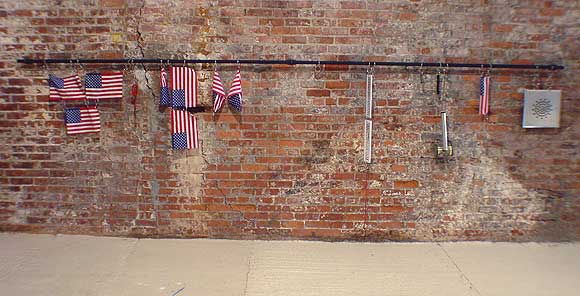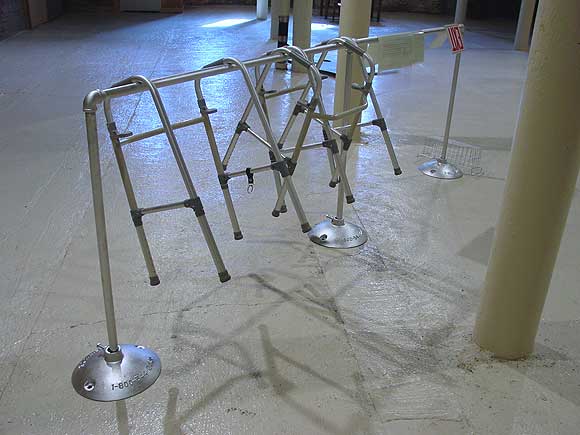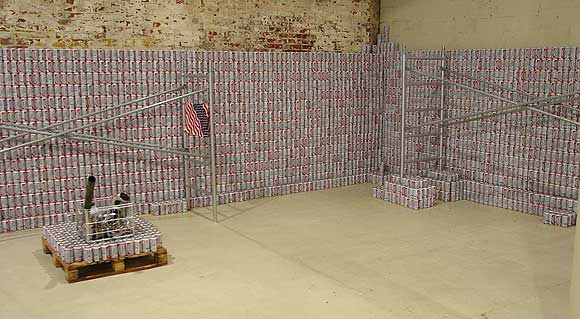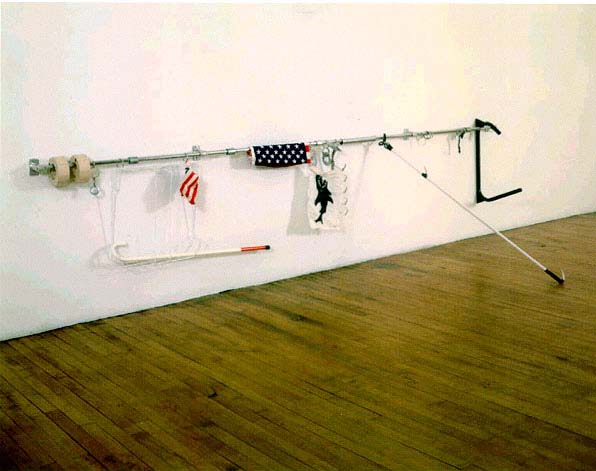View current page
...more recent posts
Triple Candie currently has a show up of "approximations" of Cady Noland's work. Noland is an influential installation artist who reached the top of the art world and "dropped out" about 10 years ago; the gallery has re-created some of her work, based on documentary sources but without consulting or notifying the self-disappeared artist. The "approximators" also published detailed notes of where they fell short in the installation process, both in finding information and relocating materials. From the press release it is obvious the project was conceived in a spirit of admiration for Noland and an intellectual fascination with "compromised forms of representation"; the eloquent commentary below by Amory Blaine (who I suspect is one of the creators or somehow involved with the project, although the gallery says it doesn't know who s/he is), describes the show as "part ghost story, part lament."
By contrast, critical response has been harsh and negative. Without any evidence to back it up, the New York Times and Village Voice interpreted the phrase "without consulting or notifying the artist" as "done against the artist's wishes" (not the same thing--what are these critics, mind readers? as Atrios would say, time for a blogger ethics panel). The Voice said Noland should "get a lawyer and get medieval on Triple Candie." Another scolding defender of Cady Noland is critic Brian Sholis, who is taken to the cleaners by "Amory Blaine" (a pseudonym from F. Scott Fitzgerald) in a colloquy from Edward Winkleman's blog, which I have reproduced immediately following Sholis' blog post.
BRIAN SHOLIS (from his blog) on Triple Candie's "Cady Noland Approximately" Show:
Far be it from me to police what a gallery chooses to exhibit, but it seems to me that making an exhibition-of-photocopied-reproductions-as-homage in the spirit of one artist [Triple Candie's David Hammons show --tm]—an exhibition that leads even the Times to wonder if the artist is involved [but wait--the Voice said Hammons was "livid" --tm]—is one thing. It is far different, and less malicious, than re-creating the artworks of an elusive artist, no matter how poorly and with how much transparency. As someone said last night at dinner, "This show cannot even begin to look like a Cady Noland show. Cady has very specific reasons for installing her objects the way she does; the relationships between them are of equal importance to the sculptures themselves. This cannot be re-created by others' hands." Hammons is enigmatic, and his relationship to exhibitions and the market can be seen, in some way, as part of his oeuvre; Noland's relationship with the art world is much closer to a categorical "no." In my mind, the differences between those stances outweigh the similarities described above.
AMORY BLAINE said... (all quotes from this point forward are from a comment thread on Edward Winkleman's blog)
Too bad Brian Sholis has bought in bulk the preciousness that the art market demands in shunning the Triple Candie project. Too bad he thinks that "cognoscenti" and "the public" are one and the same.
>>If these aren't Cady Noland sculptures, and those responsible for creating them aren't willing to claim them as something else (à la Sturtevant, or some such), then what are they?
They're approximations, Brian. One thing that you get to do when you make things in a new way, you get to name the terms. It seems that approximations may have both named and unnamed collaborators.
This show is a gesture whose faults are outweighed by the complexities of its combined virtues. It is part ghost story, part lament. Its honesty might very well be a little too intense for some to handle, but for those with a taste for that, it will taste sweet. That the beginning of Mr. Sholis's blog is laced with a threat of legal action from the artist is plenty to go on. Any writer who's first thoughts of a show include litigation should be put in the stocks. Your Fucking Face, indeed.
4/23/2006 03:12:03 PM
BRIAN SHOLIS said...
I guess I should clarify the first sentence of my post: I was not suggesting that Noland would threaten legal action. In fact, after hearing from people who know her better than I do (I've only met her once, and corresponded with her briefly), I don't think she'll do anything at all in response to the exhibition. When I wrote, ". . . that will be very short-lived if Cady Noland responds to this exhibition the way she has to exhibitions that include artworks she actually made," I was referring to the numerous recent instances in which Noland has harangued gallerists that have chosen to exhibit her work, or convinced dealers who asked for her permission to give up on including her in their shows. It has more to do with respecting Noland's wishes than any legal action. (I know of no instance where she has threatened or taken legal action.)
As I noted at the end of my post, we "need instead to stoke Noland's desire to collaborate with a gallery or institution on an exhibition of her own work." My condemnation of the Triple Candie exhibition—which I am eager to see—stems more from a disappointment in the Harlem non-profit's misunderstanding of Noland's feelings. I think Noland is one of the most important artists of her generation, and it pains me to think she might slip from our consciousness (hence "Why We Should Talk About Cady Noland"). That Triple Candie's exhibition might increase her reluctance to show her work again is in my mind a true shame.
I have the same desire that Peter and Shelly have. I just feel—again, without yet seeing the exhibition—that they have gone about achieving it in the wrong way.
Best, Brian
4/25/2006 10:40:23 PM
AMORY BLAINE said...
This trend of caring about artists' feelings is interesting and new. The other trend, however, of writing on things one hasn't seen, is not very new or interesting.
There's nothing complicated in wanting to make something contentious? It's a whole lot more complicated than serving up pablum, or offering something tried-and-true. What irritates me about some of these reactions is the knee-jerk argument of "wrongness". Are you offering that there is some objective "right"? Is that "rightness" comprised of adulation, supplication, inaction, and silent reverence?
No thanks, I don't go to that church.
And I would think that, like the Unauthorized Retrospective, this exhibition was done in the only way that triple candie could do it. In no time, with help from friends, and with very little money. I think that it's a tribute to the currency of her work that a group of people would go out of their way to make a gesture that would attempt to somehow fill the gap of her absence (a futile but encouraging effort) and bring her name out of their throats in a clear and ringing tone. More like a barbaric "Yalp" than Neil Simon's whispered "Cancer".
If anything, this show is an entreaty to Cady Noland. As much a curtain call as "Why We Should Talk About Cady Noland". It's just that it's not words, it's concrete. It's confusing. Damned ambivalent.
Looking at knock-offs is not interesting? Why not? Is it due to an overbearing sense of "the original", of some "authentic" experience? I think it is a reverence for a brand. Then there can be no satisfaction, even if the pieces were 1:1 exact replicas with no observable difference from the products straight from Ms. Noland's studio. What you're after is an interaction with your fetish object. This has absolutely nothing to do with the ideas behind Cady's work. You're only seeing what's not there. Like a petulent child who didn't get exactly what they wanted for Christmas, you're spoiling what fun is to be had for the rest of us. Mature. Adult. Human. Beings.
Boycott Triple Candie? That has got to be the most obscenely stupid thing I have ever heard. What are you going to do? Stop not giving them money? Stop not bringing all your friends to the openings? Stop not helping them install shows? Great. I can't wait to not see you around there anymore. With friends like you, who needs friends?
It saddens me to see fans and writers and critics displaying such a lack of flexibility when it comes to engaging the topic of replication, reproduction, approximation in absentia, ... alternative modes of production, folks. It's not like we haven't been here before. A million goddamn times.
What interests me is how exciting this feels. I haven't been this excited about a show and its ramifications in a very long time.
4/28/2006 06:09:28 PM
BRIAN SHOLIS said...
Hi Amory,
[...] My "caring about the artist's feelings" stems from the ramifications of this exhibition on Noland's desire to continue making (and exhibiting) her own art. What gives me most pause about "CN Approximately" is not the questions of replication, reproduction, and approximately that it raises, but rather this--admittedly nebulous and arguable--negative impact on Noland's production. For those fans of her work who hold on to the hope that she may one day reverse course and exhibit, any narrowing of the horizon of possibility is painful. For this reason I still wish that this show had not taken its current form.
Nonetheless, I agree that the thorny issues brought up by this show are productive complications, ones both exciting and well worth thinking about. I don't, however, think that this was the "only way" Triple Candie could have put the exhibition together. For clarification's sake, I never suggested boycotting the show or that looking at knock-offs is not interesting; I believe those are responses to another person commenting on this post.
At this point I have to recuse myself from further posts on this thread, as I was traveling this weekend and have personal- and work-related obligations this week that will keep me from my usual blog-reading. If you'd like to continue this conversation, however, feel free to write me (my e-mail address is in the right-hand column of the site linked to this profile). I'd be happy to keep talking (although perhaps at a slower pace) . . . especially after I have seen the exhibition.
Best, Brian
5/01/2006 12:52:26 PM
Thanks to NEWSgrist for reBlogging some of my items on Triple Candie's Cady Noland show. The story there is much more cohesive than on my own page, where the posts have been spread out over time, so please check it out.
"Spiritual America"
East Village Storefront
Manhattan
Through May 21
After famously rephotographing Marlboro ads and presenting them as his art, appropriationist Richard Prince has simulated work by photographer Garry Gross, who has freelanced for Playboy in addition to making his own figurative photography. In an East Village storefront that serves as Mr. Prince's gallery, Mr. Prince has installed a rephotographed version of Gross' image of a nude, prepubescent Brooke Shields, retitling it with the same name as the gallery, "Spiritual America."
The show might be seen as a chance to think about an oeuvre that, while mostly unfamiliar to the art world, remains pertinent to what artists like John Currin, Loretta Lux, and Inez van Lamsweerde are doing these days. Unfortunately, it is easier to see it as an attention-seeking stunt. No one in the small cult of cognoscenti that values Mr. Gross' work is going to care about seeing inexact substitutes, and no serious critical reappraisals of his art should be based on Mr. Prince's ersatz object.
The show might raise interesting questions about art and commerce, but Mr. Prince should make it clear whether he is running a gallery or doing his own conceptual art. Otherwise his project comes off as confused, confusing and duplicitous. KEN JOHNSON
My second parody based on Johnson's takedown of Triple Candie's "Cady Noland Approximately"--the first was Sherrie Levine.



Not everything in Triple Candie's re-created Cady Noland show is so great--the strips of tape holding up the rather dog-eared Oozewald simulation are a poor substitute for thumbtacks (if that's what they originally were), and some of the fabrication looked amateurish, and not in a good way--but the above three pieces are superbly done, if superb is the right word. I took these photos yesterday--I actually saw something very close to the top two works (and met Noland) when she did a large-scale exhibition at the Dallas Museum of Art in '93, and can vouch that these versions are much like what I saw. Which is to say, offhand/slacker and fanatic/Judd/minimal at the same time. The main difference was--is this crucial?--no slick white gallery walls behind them, just Triple Candie's rough brickwork.
The show isn't just about creating a room of uncanny perfect copies, a la Sturtevant's Duchamps. It's also about whether recreating an art based on past ephemera is possible. And of course, whether the participation of the artist is essential in displaying work based on available materials. The artists have published detailed notes of how much or how little they were able to redo given their budget and the vagaries of finding (or re-finding) manufactured items from 20 years ago. They are completely up front in the press release that these pictures are based on, among other things, pictures on the Internet. In his hatchet job on the show, New York Times critic Ken Johnson doesn't mention that the Web was one of the sources used, thus writing out of history the rather important theme of how we rely on Google searches and cyber-facsimiles to give us our sense of history. It's quite possible that the photos above will show up in Google Images next to jpegs of actual Nolands. Is that good? Bad? Johnson doesn't go there.
An odd contradiction in Johnson's review: in the first paragraph he mentions that Triple Candie is a non-profit gallery, and then later says the show "might raise questions about art and commerce" (that is, if the gallerists didn't have such bad motives). He is projecting a set of intentions on them that differs from the ones they announced, and then slamming them for failing (or is it not failing?) to live up to them.
Just for the record, the re-creators are Taylor Davis, Rudy Shepherd and two anonymous artists. This post has been updated as new thoughts occur to me.
Update: Jerry Saltz also bashed the show. Typically, he describes many of the reasons it's interesting and then pronounces it shit. In this case, apparently based on loyalty to Noland and attachment to his memories of first encountering her work. He thinks she should sue the gallery--excuse me, "get a lawyer to get medieval on Triple Candie." He also passes along the insinuation that the gallerists are serially doing shows against artists' wishes, adding the unattributed anecdotal information (i.e., rumor) that David Hammons was "livid" about the show they did of his work. Not livid enough to stop the show in court, though. And is saying the artist didn't like the show the same as saying the gallerists "have gone around an artist's wishes," as Saltz does? As with Johnson, that's a nasty accusation to make without proof.
Update 2: This show is bringing out some conservative reactions in critics. Brian Sholis took the same protective line as Johnson. Like Saltz, he seems to think it threatens or cheapens Noland's legacy. But he hadn't seen the show when he wrote his post--he was reacting to the press release.
Update 3: As bill says, "Real or memorex?"

"Walker Evans Approximately'": Photographs, 1934 to 1956
Artists' Space
Through May 21
Recently artist Sherrie Levine mounted an unauthorized exhibit in the form of "rephotographed" works of photographer Edward Weston, using images taken from books, catalogs and magazines. Weston's estate threatened legal action.
For her next project, Ms. Levine has simulated a Walker Evans exhibition, copying a number of of Mr. Evans' haunting Appalachian realist photographs from the 1930s and '40s, using reproductions in books and magazines as guides. The works on view include the famous photo of a weathered couple on a porch ringed by scrawny urchins, and the curled, beat-up farmer's shoes that have been compared to Van Gogh's genre studies.
The show might be seen as a chance to think about an oeuvre that remains pertinent to what artists like Sally Mann, William Christenberry, and Sebastiao Salgado are doing these days. Unfortunately, it is easier to see it as an attention-seeking stunt. No one who values Mr. Evans' work is going to care about seeing inexact substitutes, and no serious critical judgments about his art should be based on such ersatz objects.
The show might raise interesting questions about art and commerce, but Ms. Levine should make it clear whether she is a photographer or doing her own conceptual art. Otherwise her project comes off as confused, confusing and duplicitous. KEN JOHNSON
That's not really a parody, it's almost word for word what New York Times critic Ken Johnson wrote about Triple Candie's Cady Noland show. Next up, another artist who needs to make it clear what he's doing: Richard Prince.
Ken Johnson of the New York Times yesterday criticized the gallery Triple Candie for its show of Cady Noland re-creations. His review appears to contain significant factual errors, based on what I learned from a call to the gallery. For example, was Cady Noland contacted about the show before they did it? The gallery says no. Johnson says she was, and that she "rebuffed" the gallery. Where did he get this information? Also, he says Triple Candie was similarly rebuffed by David Hammons about doing a show of his work before they went ahead and did it, also apparently not true. These facts are important because Johnson's review reads like a smear job on the gallerists, suggesting they do shows motivated by personal spite. Here's what the Times published:
"Cady Noland Approximately'": Sculptures & Editions, 1984 to 1999
Triple Candie
461 West 126th Street, Harlem
Through May 21
When the artist David Hammons recently rejected an invitation to do a show at the nonprofit exhibition space Triple Candie, the gallery's directors, Shelly Bancroft and Peter Nesbett, did one anyway. They mounted an unauthorized retrospective in the form of photocopies of Mr. Hammons's works taken from books, catalogs and magazines.
Now, similarly rebuffed by Cady Noland, the influential sculptor known for refusing to cooperate with commercial galleries, Ms. Bancroft and Mr. Nesbett have simulated a Cady Noland exhibition. They invited four artists — Taylor Davis, Rudy Shepherd and two who asked not to be named — to copy 11 of Ms. Noland's darkly acerbic Neo Pop constructions, assemblages and installations from the 1980's and 90's, using reproductions in books and magazines as guides. The works on view include an installation of Budweiser beer cases, steel scaffolding, auto parts and American flag bandannas; a cut-out and perforated figure of Lee Harvey Oswald being shot; and a wooden, silver-painted Minimalist sculpture of stocks, the old instrument of public punishment.
The show might be seen as a chance to think about an oeuvre that, while mostly inaccessible, remains pertinent to what young artists like Banks Violette, Josephine Meckseper and Kelley Walker are doing these days. Unfortunately, it is easier to see it as an attention-seeking stunt. No one who values Ms. Noland's work is going to care about seeing inexact substitutes, and no serious critical judgments about her art should be based on such ersatz objects.
The show might raise interesting questions about art and commerce, but Ms. Bancroft and Mr. Nesbett should make it clear whether they are running a gallery or doing their own conceptual art. Otherwise their project comes off as confused, confusing and duplicitous. KEN JOHNSON
An earlier post I did on Triple Candie's Noland show (more specifically, its intentions announced in the press release) is here. Johnson's review is scolding, judgmental, and apparently inaccurate. His theory that the gallery is motivated primarily by backbiting and "attention-getting" lets him off the hook from actually doing much thinking about the show. Possibly he has a bee in his bonnet about artists appropriating other artists' work. As noted here a year ago, when he reviewed Elaine Sturtevant's Duchamp re-creations at Perry Rubenstein he somewhat dismissively remarked, "They love her in Europe."
Update: This post was revised from its original form. I'm looking at the show this afternoon and hope to post more thoughts later.
Atrios, Juan Cole, and Steve Gilliard are all running ads on their blogs that say "Don't let the government regulate the Internet!" Those ads are paid for by AT&T and other telecommunications companies, using the alias of a fake grassroots group. It is regulation that assures "net neutrality" and creates a level playing field between independent content-providers (like this blog) and the big companies that brought you Fox News and Britney Spears. Ending regulation means no more level playing field.
Also, we've just found out these same TelCos who want to end the Internet as we know it have been selling our personal information to law enforcement agents.
It does seem like a disconnect that there could be a benign part of the government that regulates food and drugs and keeps competition alive in the marketplace and a malignant part of the government that spies on us.
I don't think that's much justification for taking the Telcos' money and helping them spread propaganda, though. It's a bit like the footage in Fahrenheit 9/11 of Al Gore banging the Senate president's gavel repeatedly, to keep the people who voted for him from speaking out about the fraud in the 2000 election he just "lost." Working against your own interests, as it were. Epecially since the issue is so confusing. Most people will assume that those bloggers want the government's "hands off the Internet."
"Acid Casualty" [mp3 removed]
Two of my favorite CDs are 808 State's Newbuild, which is acid house made when A Guy Called Gerald was still in the group and before they "got it down" and started producing club smashes, and the collection Acid Classics, on Trax records, which is all the best stuff from Chicago in 1986-88. I love the intensity of the music and also the "I made it at home" quality. Tried to do something in that spirit here (although the synth used in the "break" is a bit more '92 hardcore rave.) No one can accuse me of being nostalgic for acid house because I had no idea it existed in '88--at least not the wack form you hear on Newbuild. I was on board by the early '90s, but by then the music had already mutated into something else. Interesting to think back to pre-Internet days--how slowly it took scenes to find their way to their potentially most enthusiastic audiences.
